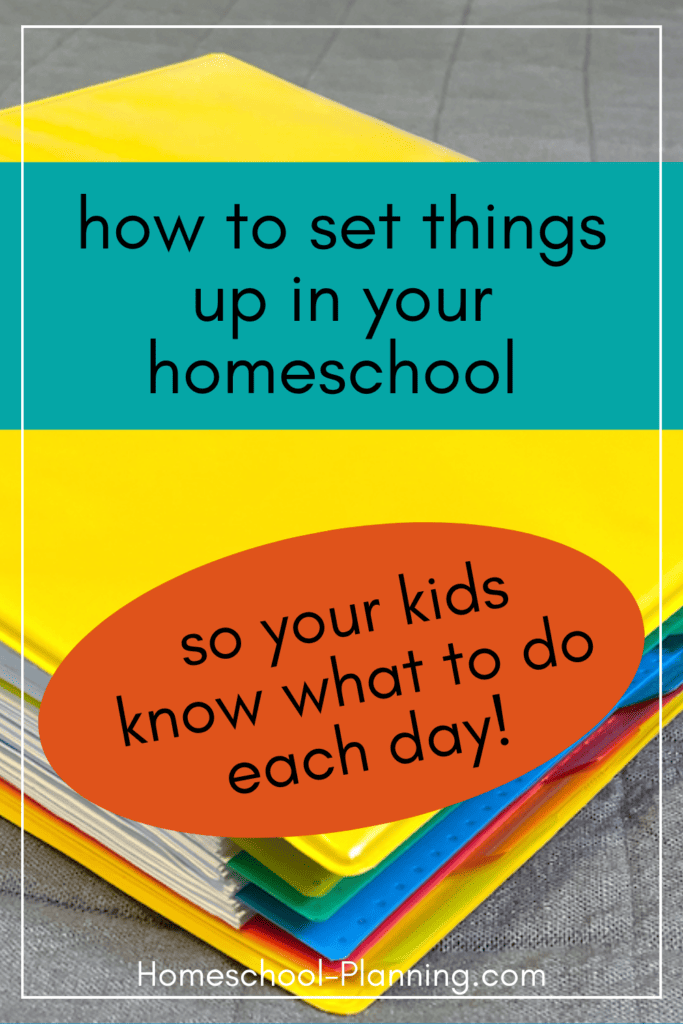You have your homeschool curriculum chosen, you know what your daily routine will be like. You might even know how many pages in each book needs to be done each day. But how do you organize the daily homeschool work to make sure your kids know what to do each day?
Do you need to open up each book for your child and walk them through each lesson? Or should you get your child a planner to keep track of their assignments?
Maybe you didn’t realize you needed a plan of action for organizing homeschool daily work. But when you woke up on the first day of your homeschool, you needed a system in place. And quickly. You’re only one person, and this homeschool thing is a lot!
In this article, we’ll be discussing many different ideas and ways to make sure your kids know what they need to do each day in your homeschool. Some moms want to keep track of every book and page, while other moms need their kids to be more independent. There is no wrong way to approach daily homeschool assignment organization.
But you do need a system. You do need a basic plan of action to get the work going. This is where you choose that system.
Keep reading to find the idea (or even more than one!) that works for you.
*Note: This post contains affiliate links, which means I receive a small commission, at no extra cost to you, if you make a purchase using the link. Please see my disclosure for more details.
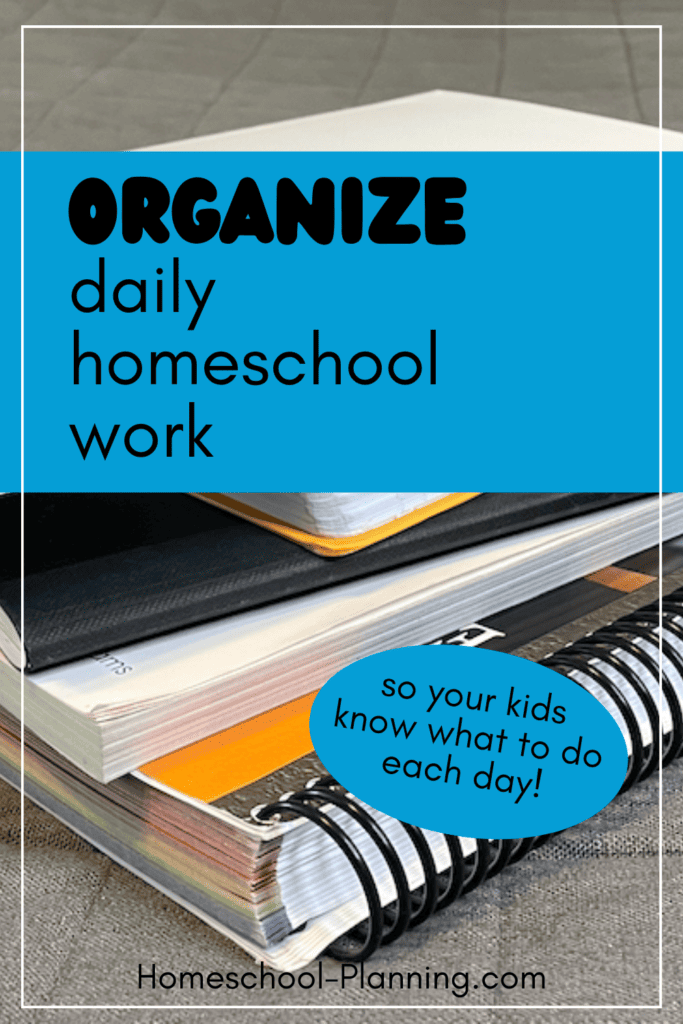
Ideas for Organizing Homeschool Daily Work
There are so many ways to get assignments organized and ready for your kids to do the work. There is no perfect way for everyone, only the right way: for the family, for that time period, for that child.
You may use a different approach for each child. It’s really about your kids and their needs and what helps them at the moment.
If you’re looking for a new idea for organizing homeschool daily work, then read on. There’s lots of goodies ahead!

1. Mom sets it out
In many homeschool families, mom will organize daily homeschool work for the kids. Each morning you might set out the books, papers, and assignments you have planned for your kids. They will come to the table and begin. Simple.
At least it’s simple for the kids.
This organizing system is fabulous for moms with motivation to prepare everything everyday and get it all set out for each child. But it does take time and attention every day.
Doing this on the fly will quickly burn you out. So it is still good to know in advance what work your kids will need to do each day. It can also be difficult if you have multiple children. If you are working with one child while another is waiting for you to let them know what to do next, chaos in your day can quickly surface.
This works well for small children or families that do group learning. But as kids get older, you might want to encourage some independence with your children, so moving on from this system may be one way to encourage that autonomy.
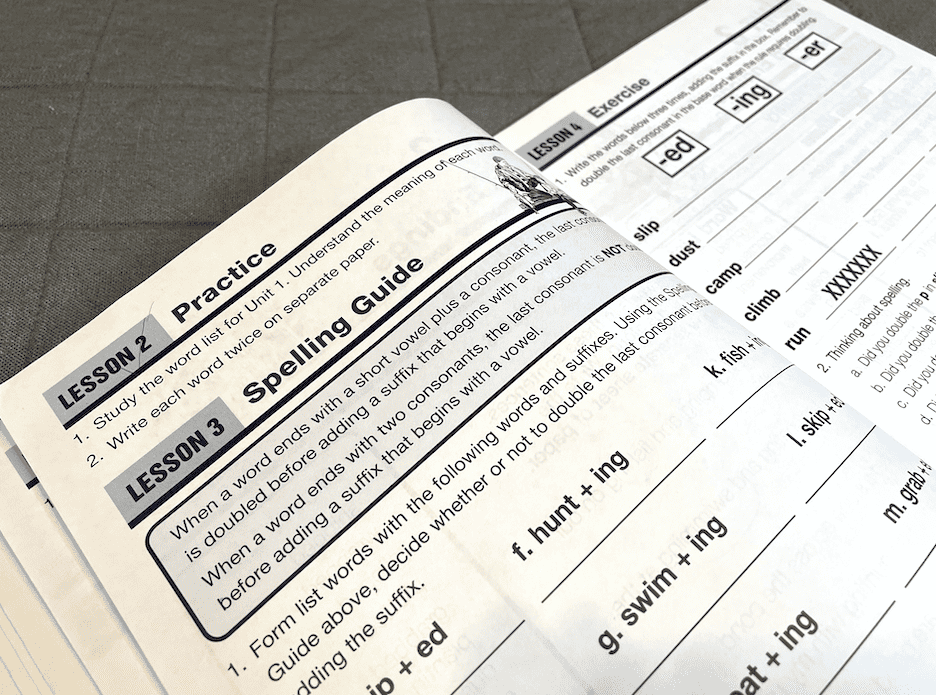
2. Do the next thing
Are you a fly by the seat of your pants kind of mom? Maybe you organize your daily homeschool work by just having your kids do the next thing. They open the book and do one lesson on day one, one lesson on day two. Each day you do the next thing in the book.
It’s pretty straight forward, right? You bought the curriculum, it’s all laid out, you just do a few pages every day. Or you open the computer and do the next lesson. Boom.
This works quite well for many families.
If you are someone who likes to know exactly what has been done and is still left to do all in one go, this may be something you do in addition to a checklist or planner.
Not every curriculum book or style works well with this approach, though. So if you like this idea but run into a stumbling block, then keep reading. Maybe something else will strike your fancy.
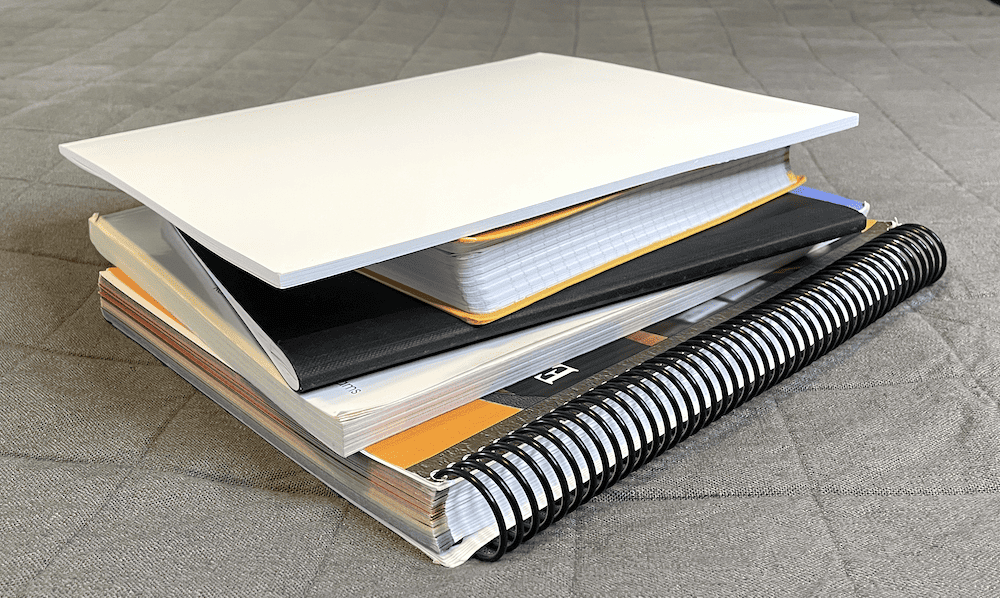
3. Pile of books
One way to organize daily homeschool work is to just have a pile of books. Each day, your child will know they need to go through the pile and complete their work. Once they have done the necessary work in each book, they are finished for the day.
Some super chill homeschool moms will buy the books, give them to their child, and tell them to finish the books by the end of the school year. This is an easy approach for the mom, but will require a lot of initiative from the child, and may not work for many.
To simplify the task a bit, come up with a certain number of pages or lessons to do in each book each day. This will take some of the guesswork away from your child and help ensure the books are all completed by the end of the year.

4. Spiral Notebook
A spiral notebook is a cheap and easy tool to use for assigning daily work in your homeschool. You can simply write a quick checklist of tasks and assignments each day for your child.
Just a cheap spiral notebook. You know, the 99-cent ones from the store.
One of the great things about this approach is that it doesn’t require anything fancy or expensive. It doesn’t take a lot of time. And you can do it as you go.
You can even add chores, music practice, and any other things you want your child to do on the list.
All they need to do is check it off as they go.

5. Checklists
Another super easy way to organize daily assignments for your homeschooled kids is to use a daily checklist. You likely have them do similar things every day, so you can make one standard checklist at the beginning of the year with the subjects and general tasks, then each day or week, write in the daily assignments. Your child then simply checks off the items as they are completed.
No one has to remember which subjects to do, you don’t have to rewrite things over and over every day. Just fill in the blanks!
6. Visual task cards
Using visual task cards can be a help to young kids, especially those who can’t read yet. Like a visual chore chart, the idea is that you will let your kids know what needs to be done by placing a picture representation of each subject on a reusable chart. The charts I have seen use hook and loop (Velcro) to attach pieces so they are removable. Your child will then use this chart to work through the daily homeschool work they need to do each day.
If your children have this instruction, you as mom will still be able to direct their day without having to give instructions for each item. You are then freed up a bit to be able to work one-on-one with one of your children without as much interruption. It is also a great way to begin teaching independence.
This would best be used in conjunction with a “do the next thing” approach for the kids. And you will need to have already decided your plans in advance.
This idea comes from homeschool blogger, author, and speaker Jamie Erickson. For more infor on visual task cards, check out her explanation here.

7. Index cards
Index cards are an easy tool to use for daily homeschool assignments. You can write a full daily checklist on one card for each day, or use one card for each subject if the full list is overwhelming to your child. These cards can even be color-coded by subject and organized by the week and day.
You can also easily add in other types of cards for things like chores or music practice. These can easily be reused.
This system is great for tactile kids that do well with things in their hands, or those that get overwhelmed by a full page of lists or pile of books. They can focus on one card at a time and will be able to see the progress as their pile of cards gets smaller as they work.
Another great thing about this system is that index cards can be easy to move around between days or even weeks if your plans need to change. Though planning too far in advance can cause a lot of potential adjustments to the system. For instance, if you assigned lesson 18 to week 18 at the beginning of the year, but lesson 5 took two weeks, think of all the cards you’ll need to move around.

8. Charts
Many homeschool curricula come with charts in the front of the book with charts that show what lesson and page numbers need to be done on which day in order to complete the curriculum within a typical school year. It is perfectly acceptable to tear out or copy these pages to use as a checklist for lessons.
They are already planned, laid out, and ready to go. Just do what it says, then check it off. Easy peasy!
I occassionally hear complaints that these charts get messy over time when you don’t complete them perfectly as planned. If you miss a day, or a lesson takes longer than expected. Do you push through and stress over getting back on schedule? If the idea of not being perfectly in line with the chart stresses you out, you may need to make some slight alterations to this system.
But don’t worry, a basic change you can easily make is to transcribe all the items in the chart to a list without days or dates. Then every day you do that subject, you just do the next item on the list. You will never be behind again!
Read: How to have a flexible homeschool schedule

9. Bookmarks
A simple bookmark with a list of daily work to complete within that book can help the child who doesn’t do well with seperate checklists or a “do the next thing” approach. They can use the bookmark to not only mark the page they are on, but to see which pages need to be completed each day and check them off as they go.
This bookmark can be a scrap of notebook paper you write on or a typed out list. You can list the daily assignments for the entire book, or just the assignments for one week.
It can be as simple as this:
Monday: Page 1
Tuesday: Pages 2-3
Wednesday: Pages 4-6
Thursday: Page 7
Friday: Pages 8-10
Occasionally you may want to find a way to assign daily homeschool work from a resource that is not easily divided into lessons or a certain number of pages each day. A solution to this is to create a basic bookmark with a list of page numbers to be done each day.
Of course you could assign the pages from this book each day by using a checklist, spiral notebook, or master list, but some kids might want a list directly in each book to reference as they go. Seperate checklist pages don’t work for every child.
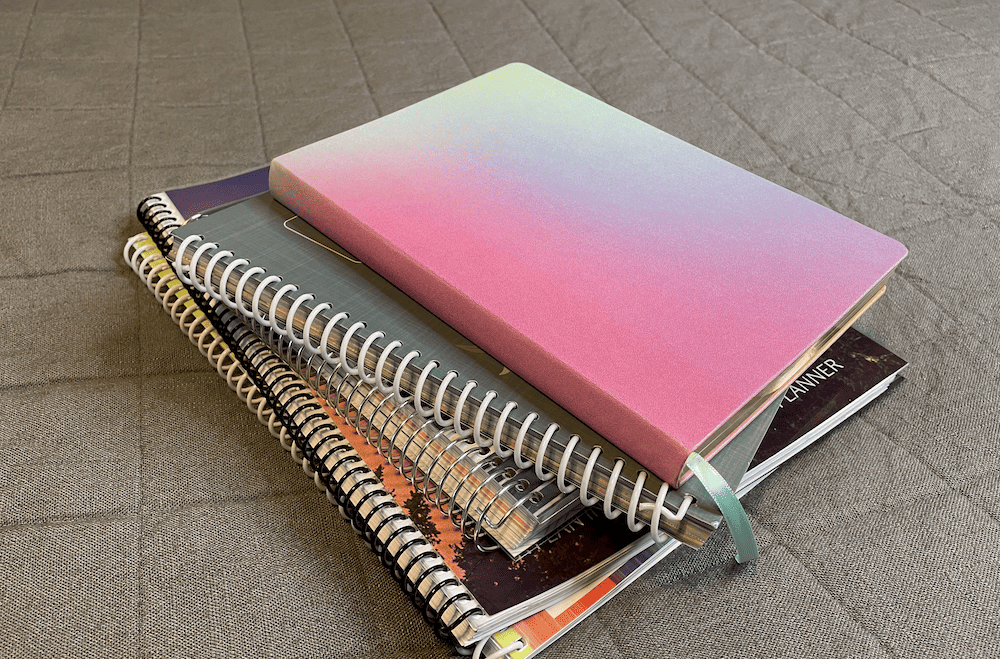
10. Planners
Planners are a simple tool many use to track and manage daily homeschool assignments. It can be in mom’s homeschool planner or a student planner. Or even an online homeschool planner that is set up for both parent and student to use it!
A student planner is one of the first things most people think about when needing a tool to manage their child’s workload. A planner works especially well for older kids to be able to write down their assignments and remember when things need to be done in the future. All in one little book.
For younger kids, mom may write assignments into the planner for the student to use and checkoff as they go. This can be a simple way to train kids to use a planner. But this same process can be used with any number of tools, like checklists, charts, and even bookmarks.
The real planner joy comes when a student learns to manage their own assignments and appointments in a planner. Not just using it as an expensive checklist.
There are many digital homeschool planners you can use with your child. In these, you can create and assign daily homeschool work, then your child is also able to see the list of assignments and check things off that have been completed!
Read: Top Digital Homeschool Planner Options
One of the top digital homeschool planners out there right now is Homeschool Planet. Definitely check it out!
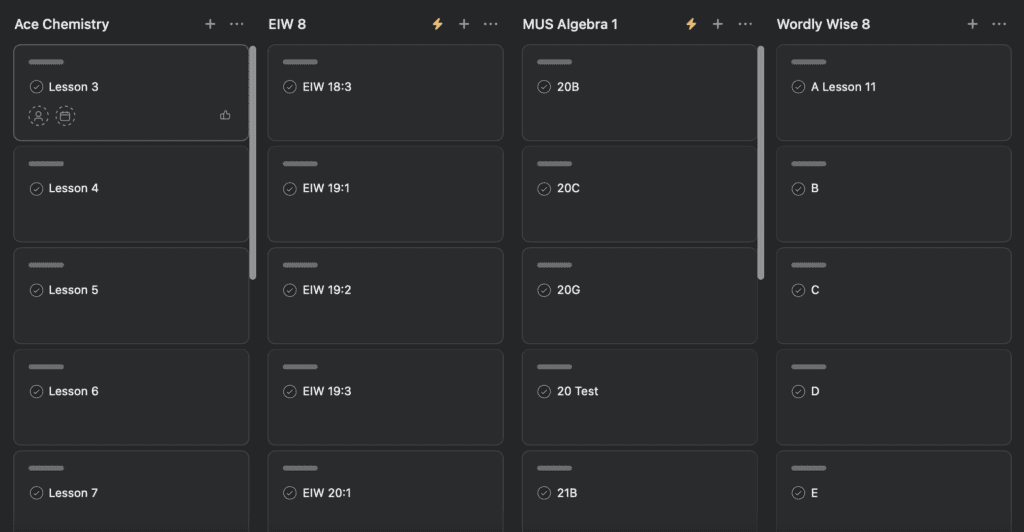
11. Master Lists
By using a master list for each subject or child for the year, you can practically take away all the daily list making. For many, taking the time to write or even fill in a checklist each day is too much. So before the year starts, make a list of the assignments that need to be done. Each day, your child will just check off the next thing on the list!
I have made these master lists and used them to fill in checklists and planners throughout the year, but have also started using them on their own with my kids.
These lists are easy to put into excel or a project management app like Asana or Trello. Each day, you or your child will simply check off the next item on the list, hopefully completing them all by the end of the year.
I particularly like master lists because you can make them and use them without attaching them to a particular day or date. So if you skip a day or need extra time, you don’t have to re-work the whole system.

12. Clipboard
Something as simple as a clipboard can help you manage your child’s daily homeschool work. You may choose to just use a checklist on the clipboard with their daily instructions listed, or you may go as far as putting all of their printables or worksheets on the clipboard as well. Your child will then have everything they need to complete their day right there.
Clipboards can make life on the go super easy as well. If you are a family who likes to take school to the park, just grab the clipboards and you’re off! Or maybe you end up doing school in the car a lot because of various appointments. This works great for that! This could be something you just use occasionally when you’re on the go or every day, even at home.
I found early on that it was helpful for my kids and I to tear their worksheets out of the book for them. Many workbooks are perforated for this reason. This way, my kids knew just what pages to do each day, and it was easier for me to check over them when they were finished.
You can still use a clipboard with a list in your homeschool day, but including all their daily work on the clipboard makes things that much easier.

13. Folders
Using folders to organize your kids’ homeschool daily work can make it super easy for them to know what to do each day. Simply include the work your child must do for the day in a folder, and in the morning they can pull out the day’s folder and get to work.
Pocket folders, manilla folders, accordion file folders, any type of folder can be helpful to organize work for your kids.
You can fill the folders for each day’s work, or you could have folders for each subject and your child will pull one day’s worksheets from each subject for the day. This of course will work better for older kids and could be a way to maintain a similar system but give a little more responsibility to your child.
Using this system relies on using either printables or tearing worksheets out from any workbooks you use. We have used this system a lot, and we love it because my kids know just what pages to do each day. It also makes it easier for me to check over their worksheets when they were finished.
The folders could be loaded in advance for the entire year, but I will say that’s risky if they are divided by the day or week far in advance. If you get behind in one subject or decide to rearrange or skip something, it will make the entire system chaos. So I suggest to stick to a shorter time frame for loading the folders, like a month or 6 weeks tops.
Over time, I started using a monthly set of manilla folders for each subject that I would then load my child’s accordion folder with each week. This system worked well for us for several years.
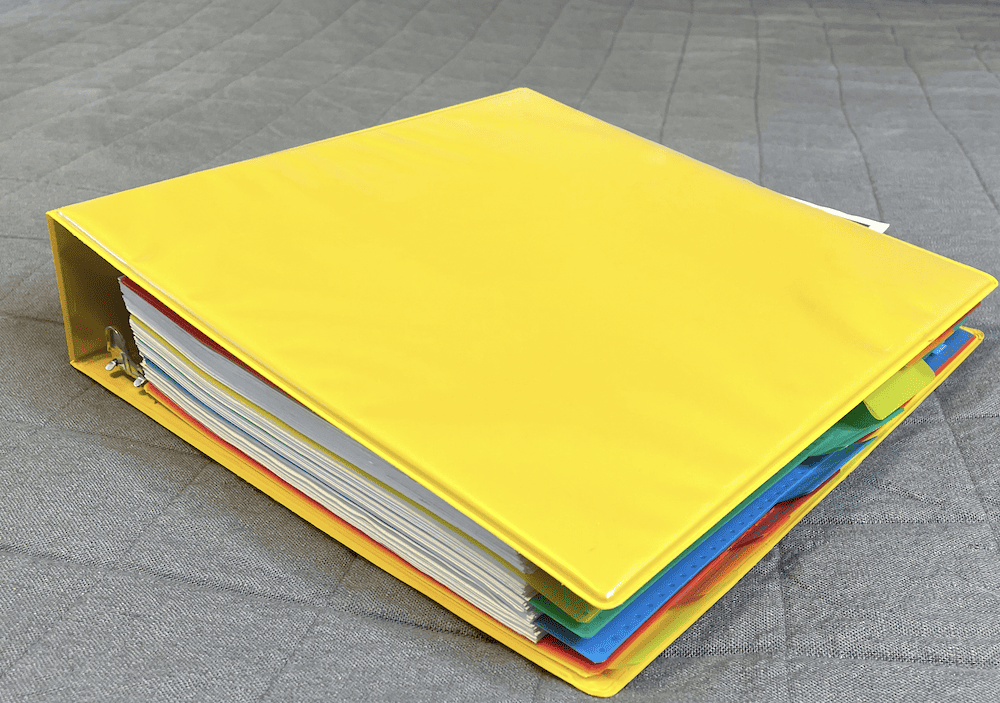
14. Homeschool binder
Many homeschool families use homeschool binders to not only organize their daily homeschool work, but also to organize their records and portfolio. For daily work, this binder includes assigned work to be done for the day or week. Labeled tabs, pockets, folders, or sheet protectors can take it a step further to keep work organized by day or subject.
A 3-ring binder is typically the base for this system, making it easy to transport when you are on the go.
This is a popular system used among homeschool families. It helps moms get organized and the kids know what to do each day. Mom can load up the binder each week, then each day, the child will just pull out their binder and get started.
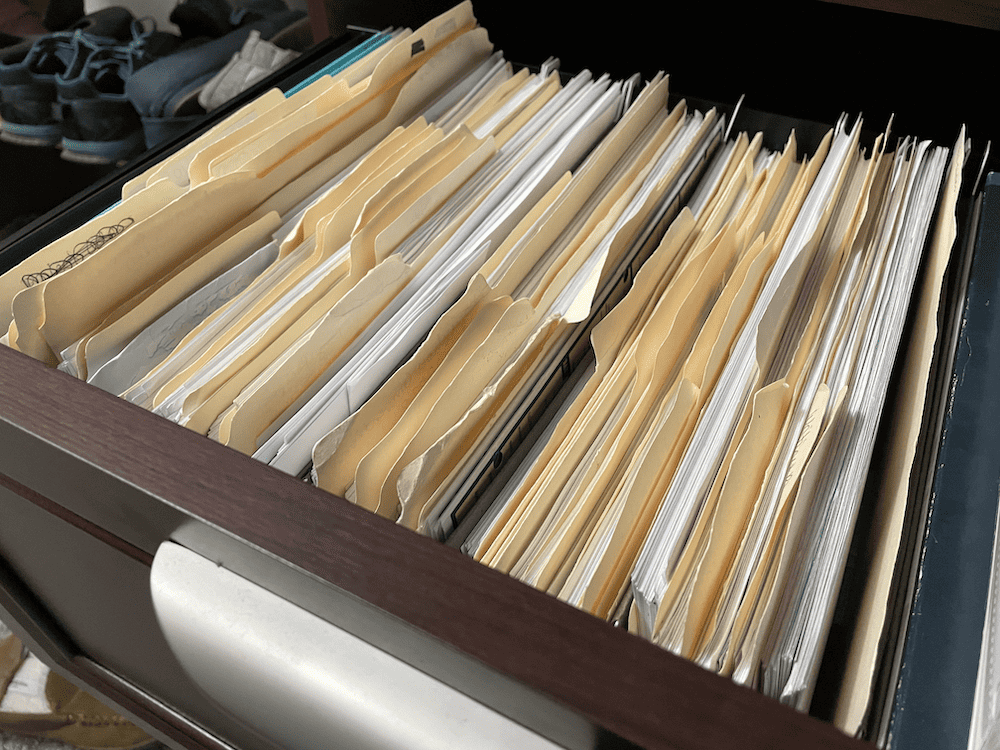
15. Crate system or file box
A crate or file box is a popular way homeschoolers organize their daily homeschool assignments. The basic system typically has a file folder for each week of school all kept in a milk crate or file box. Within these folders, you will place all the worksheets and assignments your kids need to complete, pulling out one folder each week as you move through the year.
This crate system is set up to allow you to get all the planning and organizing done at the beginning of the year. If you are good at staying perfectly on schedule, then this system will work perfect for you!
This is one of the first systems I tried when we began homeschooling around 8 or 9 years ago. And honestly I loved it, but it very quickly fell to chaos. Missing one lesson means moving every week’s assignments around, and it is just difficult!
Do note that a typical 180 day school year includes 36 weeks with 5 school days each. But if you homeschool only 4 days a week, it is good to not organize for a 5 day week, but rather organize for 45 weeks with 4 days in each. Ask me how I know. 🥴😂
16. Workboxes and drawers
Workboxes or drawers can be great tools to set things up for your kid’s homeschool work throughout the week. This is especially helpful with younger kids or kids who use a lot of hands-on manipulatives or toys in school. A small plastic tote with the day of the week or a labeled drawer will contain all the little pieces.
When it’s time for school, all your kids need to do is pull out the box for that day and get to work.
If you use some of the same things every day, you could have a box with the every day things seperate from the daily boxes to prevent having to move things each day to the next box. Or you could organize the boxes by subject.
17. Hanging file organizer
A hanging file organizer or mail sorter is often used by homeschool families to store daily homeschool work. Each slot will hold a day’s work, so all your child needs to do is grab the papers from the right slot and complete them each day.
Pretty easy! This option is similar to the folder option listed above, just a slightly different form.

FAQ

Organizing Homeschool Daily Work
Organizing daily homeschool work is a personalized journey, and finding the right system is essential for a smooth and successful experience. Whether you opt for the simplicity of checklists, the visual appeal of charts, or the versatility of digital tools, the key is to find the option that works best for both you and your child.
Remember, there’s no one-size-fits-all solution, and it’s perfectly okay to experiment with different ideas until you discover what works best for your family. Embrace the flexibility that homeschooling offers, and enjoy the process of refining and adapting your organizational approach as your child’s needs evolve.
With these 17 ideas at your disposal, you’re equipped to create a structured and engaging homeschool environment where your kids can thrive.
Have you tried any of these organizational systems? Which one works best for your family?
Related Posts
Creating a daily homeschool schedule
How to choose homeschool curriculum
All you need to know about homeschool attendance records
